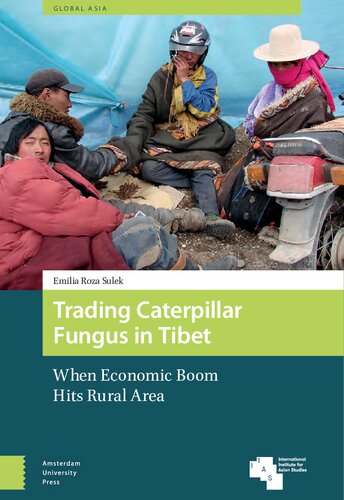Crowds thronging the streets in Golok, a pastoral region on the Tibetan plateau, signal the arrival of spring. Everyone is feverishly buying and selling. Groups of people huddle over trays of a strange-looking product. Men in black suits sit under big umbrellas with telephones glued to their ears, discussing something in hushed voices. A group of women squat on the ground, cleaning something with toothbrushes. A few steps away there is a cardboard box in the sun; a young woman guards its contents against curious onlookers. It seems as if everyone is carrying at least some of this curious product. People in restaurants pull it from their pockets and show what looks like a small, brown, dry caterpillar to their neighbours. Wherever you go, people talk about one thing. Instead of exchanging the usual greetings, they inquire ‘do you have many yartsa?’ ‘What’s the latest price?’, passengers on a bus say as a conversation starter. The words yartsa gumbu are on everyone’s lips. 1 Yartsa gumbu is the Tibetan name of a rather unusual organism, which looks like a larva with a horn growing from its head. It is a parasitic fungus (Ophiocordyceps sinensis) that feeds on caterpillars of certain species of moth that inhabit the Tibetan plateau. Advertised as a wonder drug, it commands high prices on the Chinese market and thousands of kilograms of yartsa gumbu are sold in China and abroad. But there is only one part of the world where it grows: this species of caterpillar fungus is endemic to the Tibetan plateau and the Himalayas. Golok is one of the Tibetan regions that produce caterpillar fungus and where people have built their livelihoods upon it. During the several weeks a year when this fungus is dug from the ground, it becomes everyone’s primary concern. It captures the attention of people from all walks of life and often appears in unexpected contexts
چکیده فارسی
ازدحام جمعیت در خیابانها در گولوک، منطقهای چوپانی در فلات تبت، فرا رسیدن بهار را نشان میدهد. همه با تب و تاب خرید و فروش می کنند. گروههایی از مردم روی سینیهای یک محصول با ظاهر عجیب جمع میشوند. مردانی با کت و شلوار مشکی زیر چترهای بزرگ با تلفن های چسبانده شده به گوششان می نشینند و با صدایی خاموش درباره چیزی بحث می کنند. گروهی از زنان روی زمین چمباتمه زده اند و چیزی را با مسواک تمیز می کنند. چند قدم دورتر یک جعبه مقوایی در زیر نور خورشید قرار دارد. زن جوانی از محتویات آن در برابر تماشاچیان کنجکاو محافظت می کند. به نظر می رسد که همه حداقل مقداری از این محصول کنجکاو را حمل می کنند. مردم در رستورانها آن را از جیبهای خود بیرون میآورند و چیزی شبیه یک کرم کوچک قهوهای و خشک را به همسایههایشان نشان میدهند. هر جا که می روی، مردم در مورد یک چیز صحبت می کنند. مسافران اتوبوس به عنوان شروع کننده مکالمه می گویند به جای تبادل احوالپرسی های معمول، «آیا یارتسا زیادی دارید؟»، «آخرین قیمت چند است؟». کلمات یارتسا گومبو بر لبان همه است. 1 Yartsa gumbu نام تبتی یک ارگانیسم نسبتاً غیرمعمول است که شبیه لارو است که از سرش شاخ در حال رشد است. این یک قارچ انگلی (Ophiocordyceps sinensis) است که از کرم های گونه های خاصی از پروانه ها که در فلات تبت ساکن هستند تغذیه می کند. این دارو که به عنوان یک داروی شگفت انگیز تبلیغ می شود، قیمت های بالایی در بازار چین دارد و هزاران کیلوگرم یارتسا گامبو در چین و خارج از کشور فروخته می شود. اما تنها یک قسمت از جهان وجود دارد که در آن رشد می کند: این گونه از قارچ کاترپیلار بومی فلات تبت و هیمالیا است. گولوک یکی از مناطق تبت است که قارچ کاترپیلار تولید می کند و مردم در آنجا امرار معاش خود را بر اساس آن ساخته اند. در طول چندین هفته در سال که این قارچ از روی زمین کنده می شود، دغدغه اصلی همه می شود. توجه افراد از همه اقشار را به خود جلب می کند و اغلب در زمینه های غیرمنتظره ظاهر می شود
ادامه ...
بستن ...
Author(s): Emilia Roza Sulek
Series: Global Asia 10
Publisher: Amsterdam University Press, Year: 2019
ISBN: 9789462985261,9789048536290
ادامه ...
بستن ...










